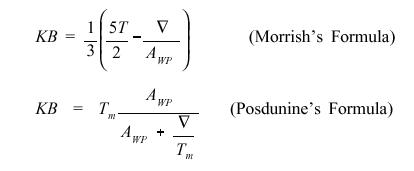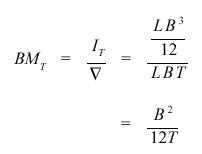Height of the Center of Gravity
The height
or vertical position of the center of gravity above the keel (KG or VCG)
is defined by weight distribution. KG can be varied considerably without
change of displacement by shifting weight up or down in the ship. Conversely,
it is possible to add or remove weight without altering KG. In most ships,
the center of gravity lies between six-tenths of the depth above the keel
and the main deck:
0.6D < KG
< DWhere,
D
= Hull depth , Keel to Main deck.
If
the height of the ship's center of gravity is known for any condition of
loading (lightship, for example), and the location of added or removed weights
is known, the new height of the center of gravity can be calculated:

Where,

Where,



Height of the Center of Buoyancy
The height of the center of buoyancy above the keel (KB) is solely a function of the shape of the underwater volume. As the centroid of the underwater hull, the center of buoyancy is lower in flat-bottomed, full-bodied ships, such as tankers and ore carriers, than in finer lined ships like destroyers or frigates. Disregarding changes in the shape of the immersed hull due to trim and heel, KB of any ship is a function of displacement, and therefore of draft. The height of the center of buoyancy can be calculated by summing incremental waterplane areas (aWP) multiplied by their heights above the keel (z) and dividing the result by the displacement volume:This expression
can be evaluated by numerical integration methods if accurate drawings
or offsets are available. In practice, KB can be approximated with sufficient
accuracy for salvage work as 0.52T for full-bodied ships and 0.58T for
fine-lined ships. At very light drafts, KB is closer to the given waterline
because the lower waterlines are usually much finer than the waterlines
in the normal draft range. As a vessel’s underwater hull form approaches
a rectangular prism (CB = 1.0), KB approaches 0.5T. The following empirical
relationships give estimates for KB that are very close to calculated values
for merchant vessels of ordinary form at normal drafts
Metacentric Height
The transverse
metacentric height (GMT), commonly called the metacentric height, of a
ship is the vertical separation of the center of gravity and the transverse
metacenter (see Figure 1-4) and is a primary indicator of initial stability.
A ship with a positive metacentric height (G below M) will tend to right
itself by developing righting arms as soon as an inclining force is applied.
A ship with a negative metacentric height (G above M) will list to either
port or starboard with equal facility until the centers of buoyancy and
gravity are on the same vertical line, and thereafter develop positive righting
arms. This condition, known as lolling, is a serious symptom of impaired
initial stability. Metacentric height is calculated by subtracting the height
of the center of gravity from the height of the metacenter above the keel:

Transverse
Metacentric Radius. The transverse metacentric radius (BMT) is the vertical
distance between the center of buoyancy and the metacenter. This distance
is termed a radius because for small heel angles, the locus of successive
centers of buoyancy approximates a circular arc, with the transverse metacenter
as its center. Metacentric radius is equal to the moment of inertia of
the waterplane about its longitudinal centerline (transverse moment of
inertia, IT) divided by the underwater volume of the hull:

For a rectangular
water plane,

And,

Where,

If the waterplane
shape can be accurately defined, the moment of inertia can be determined
by numerical integration. If not, the transverse moment of inertia of most
ships' waterplanes can be approximated by:

where CIT
is the transverse inertia coefficient and is approximated by CWP2/11.7 or
0.125CWP-0.045. These provide reasonable approximations for ships with CWP<0.9.
For ships with CWP>0.9, LB3/12 is a closer approximation of the transverse
moment of inertia of the waterplane.
References
1. http://web.nps.navy.mil/~me/tsse/NavArchWeb/1/toc.htm2. http://www.bodrum-bodrum.com/vorteks/arsenal/stability.htm
3. http://persweb.direct.ca/tbolt/stabilit.htm
4. http://homepages.tesco.net/~robin.coles/stabilit.htm
5. http://www.guillemot-kayaks.com/Design/StabilityArticle.html
6. http://web.nps.navy.mil/~me/tsse/NavArchWeb/1/module6/basics.htm
7. http://www.math.ubc.ca/~ttsai/m317/buoyancy.pdf
To the top of the page
Site maintained by Binoy Perumpalath,
If you wish to copy, change or alter in anyway please contact Binoy Perumpalath at binoy@email.com
Last modified on 07 April 2004.